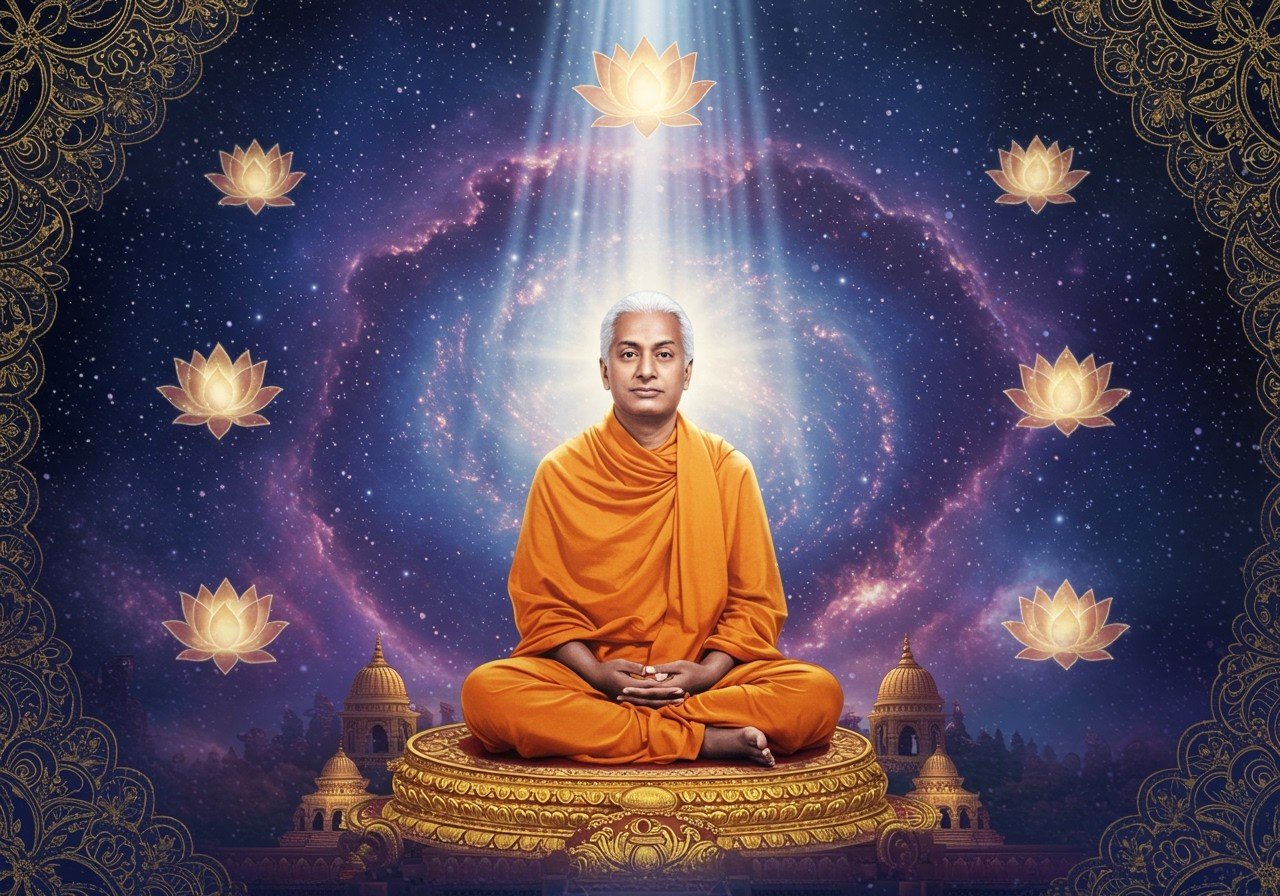
Understanding Mahasamadhi is crucial for those who value tradition and spirituality. This profound concept, especially seen through the life of Paramahansa Yogananda, offers deep insights into the conscious exit from the body by a realized yogi at the time of their physical death. Yogananda’s Mahasamadhi holds significant cultural and spiritual meaning for people across the globe, serving as a beacon of his spiritual legacy and teachings.
Paramahansa Yogananda’s Spiritual Journey
Born in 1893 in Gorakhpur, India, Paramahansa Yogananda embarked on a spiritual journey that eventually led him to establish the Self-Realization Fellowship in the United States. He played a vital role in introducing the practices of yoga and meditation to Western audiences, bridging the gap between Eastern and Western spiritual thought. His renowned book, ‘Autobiography of a Yogi,’ continues to be a spiritual classic, inspiring seekers worldwide. Deeply influenced by his guru, Swami Sri Yukteswar, Yogananda’s mission became one of promoting universal spiritual understanding, encouraging individuals to delve into deeper spiritual connections within themselves.
The Event of Mahasamadhi
On the tranquil evening of March 7, 1952, in Los Angeles, a remarkable event unfolded. Paramahansa Yogananda, the revered spiritual teacher, attended a banquet in honor of India’s Ambassador to the US, Binay Ranjan Sen. His presence radiated serenity, his demeanor calm and composed. He delivered a heartfelt speech, speaking eloquently about the spiritual unity between India and America. Then, in a moment of profound stillness, Yogananda entered Mahasamadhi. This was not an ordinary passing, but a conscious and intentional transition from his physical form. Witnesses described a peaceful departure, a testament to his mastery over life and death. For those present, it was a deeply impactful moment of spiritual awakening.
Meaning and Significance of Mahasamadhi
Mahasamadhi holds profound meaning in Hindu and yogic traditions. It represents the conscious release of the soul from its physical embodiment. A yogi who attains Mahasamadhi reaches the highest state of cosmic consciousness, remaining aware even as they transcend their mortal frame. This conscious departure surpasses the limits of ordinary human awareness. It indicates the individual has transcended their karma, the law of cause and effect, and are liberated from the cycle of birth and death, achieving moksha. It stands as a testament to their spiritual attainment and liberation. Paramahansa Yogananda’s Mahasamadhi serves as a powerful validation of his teachings, exemplifying the eternal nature of the soul and the possibility of attaining divine consciousness.
Paramahansa Yogananda’s Legacy
Paramahansa Yogananda’s legacy continues to thrive through his teachings and spiritual contributions. His Mahasamadhi served to reinforce the principles he imparted throughout his life, emphasizing meditation and self-realization. He stressed the importance of inner exploration and connecting with one’s true self. The Self-Realization Fellowship, which he established, continues to disseminate his teachings across the globe. His book, ‘Autobiography of a Yogi,’ remains a cornerstone of spiritual literature, bridging Eastern and Western philosophies and guiding seekers on their spiritual paths. His impact goes beyond his physical presence, offering solace and direction to those seeking spiritual growth and understanding in today’s world. His life and legacy serve as a powerful reminder of the timeless wisdom he shared with the world.
The Resting Place of a Spiritual Luminary
Paramahansa Yogananda’s final resting place is at the Forest Lawn Memorial Park in Glendale, California. This site holds deep significance for his followers and admirers, many of whom visit as a place of pilgrimage to offer their respects and draw inspiration. The memorial reflects Yogananda’s mission to bridge Eastern and Western spiritual traditions, symbolizing his enduring influence on global spirituality. The site continues to receive reverence and respect, embodying the widespread love and admiration for his immeasurable contributions to humanity. His teachings continue to resonate, guiding individuals toward spiritual awakening and deeper understanding. His life served as a testament to the unity of spirit and matter, offering hope to those on their individual spiritual journeys.
How Poojn.in Supports Your Spiritual Journey
At poojn.in, we understand the deep significance of Mahasamadhi and offer a curated selection of authentic items to support your spiritual practice, perfectly aligned with yogic traditions. We offer:
- Pure brass and copper incense holders for meditation: Explore our collection of incense holders. These beautiful pieces elevate your meditation space and enhance the aromatic experience.
- High-quality dhoop and incense sticks for creating a sacred atmosphere: Discover our range of dhoop and incense. Choose from a variety of traditional fragrances to create a serene and sacred environment for your practice.
- Traditional meditation cushions and asanas for comfortable spiritual practice: Find the perfect cushion or asana. Comfort is key for extended meditation, and our selection provides the support you need for a deeper practice.
We also offer pure cotton meditation shawls, yoga mats, and specially curated puja thalis for offering prayers. Visit poojn.in today to explore our complete range of spiritual and puja items. We offer pan-India delivery and secure payment options for your convenience. Note: All items are blessed and packaged according to traditional customs before shipping.
For personalized assistance in selecting items for your spiritual practice, please contact us:
- Phone: 03369029784
- WhatsApp: 9476142738
Embracing the Eternal Journey
Paramahansa Yogananda’s Mahasamadhi is not just an end, but a new beginning for countless spiritual seekers. His conscious departure from this physical realm serves as an enduring beacon of hope, a reminder of the eternal nature of the soul. Yogananda’s teachings continue to inspire and guide those who seek to understand the deeper truths of existence. His legacy lives on in the hearts of his followers, motivating them to explore the profound depths of meditation and self-realization.
Yogananda’s life and teachings beautifully bridge Eastern and Western spiritual traditions, offering timeless wisdom that transcends cultural boundaries. As we reflect on his Mahasamadhi, we are reminded of the timeless journey that each soul undertakes. Yogananda’s message remains clear: through dedication and inner exploration, we too can aspire to reach the heights of spiritual consciousness. His life is a powerful testament to the possibility of unity, peace, and enlightenment, guiding us all towards a path of love and understanding. You can read more about Bhakti Yoga on our website.
FAQs on Mahasamadhi
What is Mahasamadhi? Mahasamadhi is the conscious exit of a yogi from their physical body—a spiritual liberation symbolizing ultimate union with the divine. It’s a state of profound spiritual enlightenment where the individual transcends the limitations of the physical realm.
When did Paramahansa Yogananda attain Mahasamadhi? Paramahansa Yogananda attained Mahasamadhi on March 7, 1952, during a banquet honoring India’s Ambassador to the US in Los Angeles, California. This event became a pivotal moment for his followers, solidifying his teachings on life, death, and spiritual transcendence.
How did Paramahansa Yogananda die? Paramahansa Yogananda’s passing was incredibly peaceful. He entered Mahasamadhi while delivering a speech, demonstrating a conscious and serene transition from the physical world. It was a testament to his spiritual mastery and deep connection with the divine.


